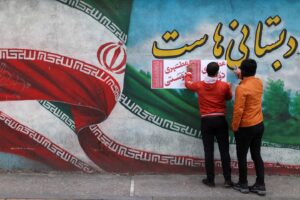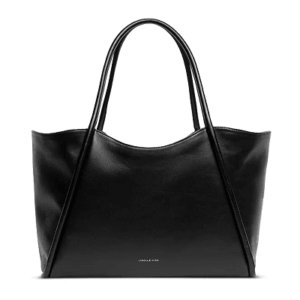[ad_1]

Kazanevsky and his wife, Lyudmila, left the city for Western Ukraine on a planned vacation. Yet for several days, he was in a fog of shock. Barely sleeping, he continuously talked with colleagues and watched the news. Then one night, his creative hand was moved to render judgment on what he was witnessing.
“I began to feverishly think and draw, think and draw,” Kazanevsky says by email from Slovakia, near the Ukrainian border. “The brain refused to realize that everything that was happening was not a nightmare. Is it really real when, in the heart of Europe, in front of the whole world, a crazy dictator with his zombie army is trying to destroy an entire nation?”
Story continues below advertisement
Soon what emerged was the acclaimed political artist’s first commentary on the invasion. In stark black lines, he depicted the Grim Reaper reaching out to push a red nuclear button on Putin’s forehead.
What followed was a series of cartoons that imagined Putin and Death as characters in an ongoing drama of horrific metaphors: The Reaper acting as therapist to a leader bent on mass destruction, or riding a Putin-faced tank, or presenting the Russian leader with a bouquet of targeted Ukrainian soldiers. Kazanevsky began drawing them in Ukraine and has continued his Putin cartoons since departing his country for a while because of the war.
The head of Kazanevsky’s California-based syndicate, Cagle Cartoons, calls him the most important editorial cartoonist in Ukraine. Whatever perch he has, Kazanevsky, 71, simply sees himself as a journalist fighting “an information war.”
“There is a proverb: If the guns speak, the muses are silent,” Kazanevsky says. “Only, this does not apply to the art of the cartoon. Because the cartoon is an active weapon.”
Kazanevsky is also attuned to history — how Hitler sought to silence editorial cartoonists, and Napoleon knew the influence of visual depictions. “Authoritarian rulers are afraid of political cartoons,” he says, noting that today such art is bolstered by the reach and immediacy of the Internet.
Story continues below advertisement
He also knows the power of wordless art that relies on universal visual metaphor: “It is important to try to show the truth through cartoons that are understandable everywhere.”
Kimberly Lusk, opinion page editor at the Spokane Spokesman-Review in Washington state, recently spotlighted some of Kazanevsky’s art. “There are so many cartoons about Ukraine to choose from these days,” she says, noting that she thought his “perspective from inside the country was an interesting one to give our readers, especially since we have a fairly large Ukrainian American population in our region.”
When Kazanevsky left Kyiv, he left behind most of his supplies. He drew on paper while on the go, but lacking a computer and scanner, he sent out his cartoons by taking pictures of them with his smartphone.
Story continues below advertisement
Eventually, when refugees started arriving in Western Ukraine, creating a “humanitarian catastrophe,” he says, he and Lyudmila — who have two grown children back in Kyiv and Lviv — crossed the border by foot. They stopped in a Polish town before friends took them to Presov, Slovakia, which Kazanevsky says has a fertile artistic community.
Kazanevsky, who says he once worked in a military factory, was fascinated by space radiophysics and literature before he began to appreciate that cartoons could be intellectual weapons — a realization that dawned upon him during the Orange Revolution, when Ukraine’s 2004 presidential election sparked wide social unrest.
Now, he sees his art as antidote to false messaging: “For many years, Russian propaganda has zombified not only its fellow citizens, but also citizens of other countries.”
The sharpest political cartooning often requires not only a gift for metaphor, but also a passion that flows through the pen. Kazanevsky draws Putin as if it is a painful call to action.
Story continues below advertisement
“Strong feelings come to me,” Kazanevsky says. “I hate him with all my heart. I just can’t look at his picture.” The artist does not try to draw a precise physical likeness of Putin; instead, his caricatures are guided by emotional interpretation.
Kazanevksy first aims to capture his eyes: “They are deep-set, close to each other. These eyes are angry, cold, wolflike. … These are the eyes of a man who has emerged from the dark hole of the KGB.” He then draws “the bulging cheekbones” of a “stubborn” military leader and the large, bowlike lips of a “person who loves comfort and attention.”
The artist says even the act of caricaturing Putin takes a toll on him: “I want to drink horilka with pepper or whiskey, but my health does not allow it,” referring to the Ukrainian alcoholic beverage.
Story continues below advertisement
Kazanevsky finds hope, though, in the leadership of Ukrainian president Volodymyr Zelensky, as well as the resilience of his nation’s forces. “We are confident that we will win and are grateful to the whole world, especially the American people for their support,” he says. “All criminals led by Putin will sit on the dock of the new Nuremberg trials.”
He has created a cartoon that he believes foretells the fate of Putin. The Russian leader is at the helm of a nuclear Titanic, about to strike the iceberg that is Ukraine.
In his optimism, Kazanevsky did not depart Kyiv with a sense of dread. Slinging on a backpack, “I felt unusually light and seemed to be rejuvenated. I left everything at home: the original paintings and drawings, thousands of catalogs and books, my favorite brushes and paints. But for some reason, I didn’t feel sorry for them.”
That is because he envisions an eventual journey back. “We know that we will win, and we dream of returning home as soon as possible.”
[ad_2]
Source link





